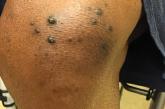Article

New skin papules
- Author:
- Aakash Modi, MD
- J. Lane Wilson, MD
The location of the patient’s lesions, as well as her underlying conditions, pointed to the diagnosis.
Article

Growing scalp nodule
- Author:
- J. Lane Wilson, MD
Was this a malignant lesion or an unusual presentation of a benign nodule?
